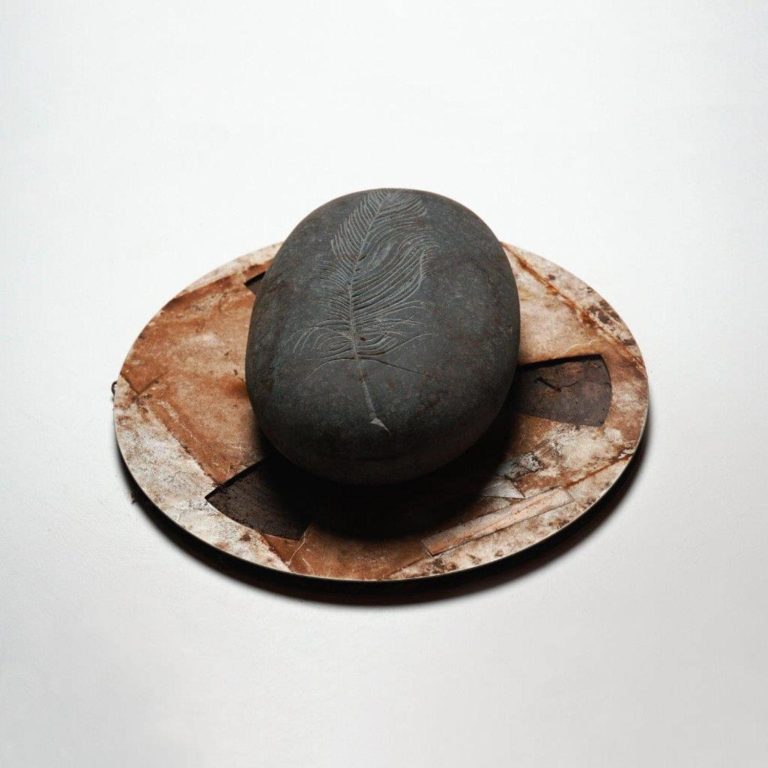If you hear the recording of Erland Cooper’s latest work, Carve the Runes Then Be Content With Silence, and think it sounds like some old work that has been excavated from the ground, then you’re kind of on the money. In May 2021, the Scottish composer buried the ¼ inch magnetic master tape and sheet music of his album, deleting the digital files afterwards. He left clues for any fans (or record label execs) who wanted to go on a treasure hunt to find the album, issuing a map and releasing extra clues every equinox and solstice. All the while, the music sat in the soil, decaying in parts as the earth swallowed sounds from the tape. The whole process brings a whole new meaning to the word ‘composition’.
Orkney residents Victoria and Dan Rhodes did eventually find the buried treasure in 2022, whereafter the tape dried out on public display until its release this year. Premiered back in June, where the tape was played and Erland’s interpretation and re-scoring of the master was performed by a large string ensemble. To hear the tape after all this time does feel poignant and amazing in its own kind of way; there was the real risk that the earth would have destroyed the music entirely. (Cooper also did entrust three copies of the score to three custodians; Paul Weller, author Ian Rankin and radio presenter Elizabeth Alker.) The music crackles crisply every so often, and the sound drops from one stereo channel here and there, like you’re listening on a pair of faulty headphones. It can be frustrating at times, but each ‘imperfection’ serves as a reminder of the album’s story, adding texture and compositional touches that would be impossible to recreate artificially in this exact way.
The main downside is that the story of the album’s creation and ‘co-composition’ is arguably the most interesting thing about it. The story is fascinating and original, rooted in inspiration of the natural world, time and patience, and resilience. Erland’s writing captures this in various forms: the screeching strings on “Carve The Ruins (Mvt. 1) – Pt. 1 bouncing and bending in the harbour” are like the chatter of birdsong in the morning; phases of “Then Be Content (Mvt. 2) – Pt. 2 driftweed scored the strings” are dark and dense like the surrounding soil; and the two minute “With Silence (Mvt. 3) – Pt. 1 ‘con la memoria’” is half silence, a deliberate ‘memorial piece’ which acts as a pause and a moment of reflection (and was a curious first pre-single released digitally back in June). As an ode to its various muses, the album feels like a personal document; you can picture Erland looking out onto the landscapes from his childhood home in Orkney and absorbing the displays of nature to then capture in his score.
While the whole thing runs just over half an hour and is easy to consume in a single sitting (though the occasional long silences do become frustrating after repeated listens), there are easily identifiable highlights. “Then Be Content (Mvt. 2) – Pt. 3 walking through heather and peat” is rich and graceful, building in volume as melodic layers add up. Strings call out like sirens, and there’s a magical ineffable feeling the movement captures, much like Max Richter’s best work evokes. Similarly the final piece “With Silence (Mvt. 3) – Pt. 4 sunwards turn” flutters like birds chasing each other in the sky, and could well be the heartwarming climactic piece from a film’s final moments. Moments like these tickle the hairs on the back of your arms and neck to an upright position, and even though the audio is decayed in parts, they endure as musical pieces that could stand strong out of the context of the album.
Across the album are also excerpts from Orkadian poet George Mackay Brown. His fatherly voice and friendly, Scottish inflections add a much needed anchor for some of the album’s most uneventful moments and also compliment the nature of the music. “Between crib and coffin you must dance in a beautiful coat,” he offers at the end of the first movement as an airy waltz unspools wistful swirls of strings with a Celtic pang. Carve the Runes Then Be Content With Silence is that beautiful coat, a sliver of time where Cooper and the earth combined to make something. The story is curious and fascinating enough to tell for years to come, a risky venture that created a unique final product. Time bred the music as much as the composer, and like a time capsule being unearthed, it’s quite a marvel to see what survived, thrived, and changed when surrounded by soil. Music lives on, this much we now know is true.

